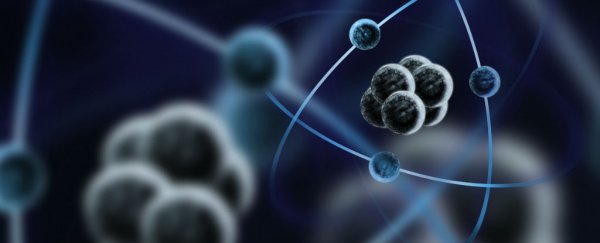In 1930, German theoretical physicist Werner Heisenberg came up with a thought experiment, now known as Heisenberg's microscope, to try to show why it's impossible to measure an atom's location with unlimited precision. He imagined trying to measure the position of something like an atom by shooting light at it.
Light travels as a wave, and Heisenberg knew that different wavelengths could give you different degrees of confidence when used to measure where something is in space. Short wavelengths can give a more precise measurement than long ones, so you'd want to use light with a tiny wavelength to measure where an atom is, since atoms are really small. But there's a problem: light also carries momentum, and short wavelengths carry more momentum than long ones.
That means if you use light with a short wavelength to find the atom, you'll hit the atom with all of that momentum, and that kicks it around and risks completely changing its location (and other properties) in the process. Use longer wavelengths, and you'll move the atom less, but you'll also be more uncertain about your measurement.
You're in a bind: any measurement changes what you're measuring, and better measurements lead to bigger changes.
It's also possible to prepare atoms in what's called an entangled state, which means they act cooperatively like a single atom, no matter how far away they are from each other. If you push one, the rest move like you pushed them all individually. And if you mess up one atom by shooting some light at it, you generally mess up the whole collection.
In the past, these two effects made it impossible to measure how entangled atoms are arranged without destroying the arrangement and the entanglement – which were presumably prepared for some specific purpose, like to make a quantum computer.
But now, physicists led by T. J. Elliott from the University of Oxford in the UK have proposed a way to measure large-scale properties of a group of entangled atoms without messing up the entanglement. It isn't measuring individual atoms – that's permanently off-limits – but it's more than physicists have managed to do before.
Usually, when physicists entangle atoms, they have to be careful that the atoms are all more or less the same when they start out. If there are lots of different kinds of atoms in there, they become a lot harder to match up, so the entanglement becomes more fragile.
But it's still possible to make stable groups of entangled atoms that have some outliers among them that are unlike the main group, and the paper's authors have shown that these outliers can be used to measure things about the main group without messing up their entanglement.
This includes really basic information like the density of atoms – how closely they are to one another – while they're entangled, which historically has been out of physicists' reach in individual experiments.
Before, physicists had to measure a whole bunch of the entangled atoms really quickly, and they'd have to accept that they were changing things around as soon as they measured that first atom. More measurements might check more atoms, but they'd be increasingly uncertain as time went on.
Now, all they have to do is measure what the outliers are doing and they can figure out how the atoms are distributed without the chaos. Within some limits, knowledge about the atoms' density gets better – not worse – as more measurements are made.
Admittedly, measurements still change things a little bit (light is still being used and Heisenberg's microscope still applies) but the measurements won't wreck the whole system like they would have before.
This method of measuring the outliers is a window into a new realm for physicists, who could previously only see what entangled atoms did, not what they're doing.
The researchers simulated a simple system as a proof-of-concept, but they showed mathematically that this should work with a wide range of quantum systems where entanglement plays a key role. And small changes to the method could make it possible to measure properties like the magnetisation of entangled atoms, instead of just their density.
All with atoms that shouldn't be in the group in the first place. Not bad, physicists. Not bad.
The research has been published in the journal Physical Review A.
